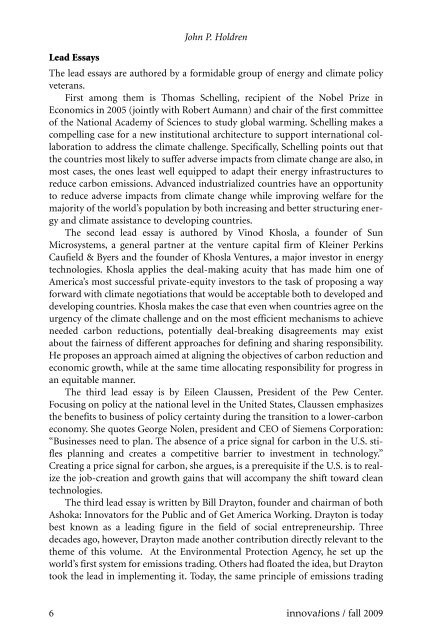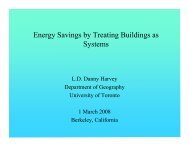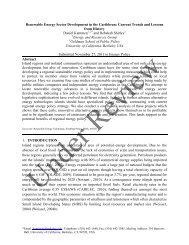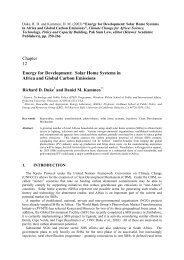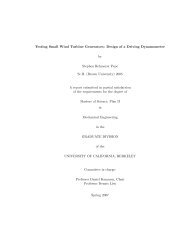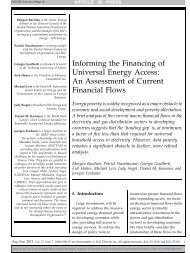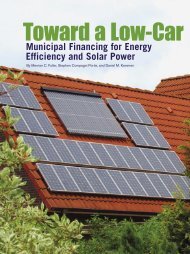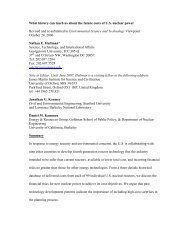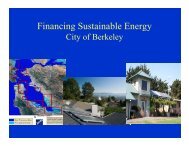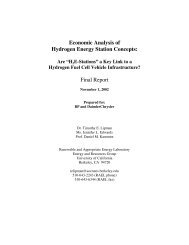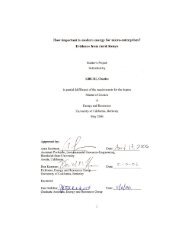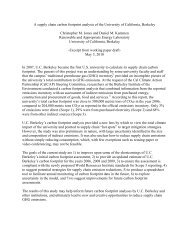Innovations, Energy for Change, Fall 2009.pdf - Renewable and ...
Innovations, Energy for Change, Fall 2009.pdf - Renewable and ...
Innovations, Energy for Change, Fall 2009.pdf - Renewable and ...
Create successful ePaper yourself
Turn your PDF publications into a flip-book with our unique Google optimized e-Paper software.
John P. Holdren<br />
Lead Essays<br />
The lead essays are authored by a <strong>for</strong>midable group of energy <strong>and</strong> climate policy<br />
veterans.<br />
First among them is Thomas Schelling, recipient of the Nobel Prize in<br />
Economics in 2005 (jointly with Robert Aumann) <strong>and</strong> chair of the first committee<br />
of the National Academy of Sciences to study global warming. Schelling makes a<br />
compelling case <strong>for</strong> a new institutional architecture to support international collaboration<br />
to address the climate challenge. Specifically, Schelling points out that<br />
the countries most likely to suffer adverse impacts from climate change are also, in<br />
most cases, the ones least well equipped to adapt their energy infrastructures to<br />
reduce carbon emissions. Advanced industrialized countries have an opportunity<br />
to reduce adverse impacts from climate change while improving welfare <strong>for</strong> the<br />
majority of the world’s population by both increasing <strong>and</strong> better structuring energy<br />
<strong>and</strong> climate assistance to developing countries.<br />
The second lead essay is authored by Vinod Khosla, a founder of Sun<br />
Microsystems, a general partner at the venture capital firm of Kleiner Perkins<br />
Caufield & Byers <strong>and</strong> the founder of Khosla Ventures, a major investor in energy<br />
technologies. Khosla applies the deal-making acuity that has made him one of<br />
America’s most successful private-equity investors to the task of proposing a way<br />
<strong>for</strong>ward with climate negotiations that would be acceptable both to developed <strong>and</strong><br />
developing countries. Khosla makes the case that even when countries agree on the<br />
urgency of the climate challenge <strong>and</strong> on the most efficient mechanisms to achieve<br />
needed carbon reductions, potentially deal-breaking disagreements may exist<br />
about the fairness of different approaches <strong>for</strong> defining <strong>and</strong> sharing responsibility.<br />
He proposes an approach aimed at aligning the objectives of carbon reduction <strong>and</strong><br />
economic growth, while at the same time allocating responsibility <strong>for</strong> progress in<br />
an equitable manner.<br />
The third lead essay is by Eileen Claussen, President of the Pew Center.<br />
Focusing on policy at the national level in the United States, Claussen emphasizes<br />
the benefits to business of policy certainty during the transition to a lower-carbon<br />
economy. She quotes George Nolen, president <strong>and</strong> CEO of Siemens Corporation:<br />
“Businesses need to plan. The absence of a price signal <strong>for</strong> carbon in the U.S. stifles<br />
planning <strong>and</strong> creates a competitive barrier to investment in technology.”<br />
Creating a price signal <strong>for</strong> carbon, she argues, is a prerequisite if the U.S. is to realize<br />
the job-creation <strong>and</strong> growth gains that will accompany the shift toward clean<br />
technologies.<br />
The third lead essay is written by Bill Drayton, founder <strong>and</strong> chairman of both<br />
Ashoka: Innovators <strong>for</strong> the Public <strong>and</strong> of Get America Working. Drayton is today<br />
best known as a leading figure in the field of social entrepreneurship. Three<br />
decades ago, however, Drayton made another contribution directly relevant to the<br />
theme of this volume. At the Environmental Protection Agency, he set up the<br />
world’s first system <strong>for</strong> emissions trading. Others had floated the idea, but Drayton<br />
took the lead in implementing it. Today, the same principle of emissions trading<br />
6 innovations / fall 2009


